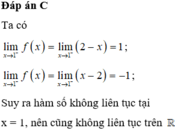

Hãy nhập câu hỏi của bạn vào đây, nếu là tài khoản VIP, bạn sẽ được ưu tiên trả lời.



Ta có:
\(f\left(1\right).f\left(-1\right)=\left(a+b\right).\left(-a+b\right)\)
\(\Rightarrow\left(a+b\right)\left(-a+b\right)=\left(a+b\right)^2\)
\(\Rightarrow-a+b=a+b\)
\(\Rightarrow a=-a\)
\(a\ne0\) thì làm sao có a thỏa mãn được?
Trần Thùy Dung ko biết thì đừng có làm. 5 - 3a - 3b = 5. Bài này trong violympic.

Từ \(f\left(x\right)+f\left(\frac{1}{x}\right)=x^2\); lần lượt thay \(x=2\) và \(x=\frac{1}{2}\) vào, ta có:
\(f\left(2\right)+3f\left(\frac{1}{2}\right)=4\) và \(f\left(\frac{1}{2}\right)+3f\left(2\right)=\frac{1}{4}\Leftrightarrow3f\left(2\right)+f\left(\frac{1}{2}\right)=\frac{1}{4}\)
Giải hệ phương trình với 2 ẩn \(f\left(2\right)\) và \(f\left(\frac{1}{2}\right)\)
Tìm được \(f\left(2\right)=\frac{-13}{32}\)
Ta có \(f\left(x\right)+3f\left(\frac{1}{x}\right)=x^2\) (1)
Thay \(x\rightarrow\frac{1}{x}\) được \(f\left(\frac{1}{x}\right)+3f\left(x\right)=\frac{1}{x^2}\)
\(\Leftrightarrow3f\left(\frac{1}{x}\right)+9f\left(x\right)=\frac{3}{x^2}\) (2)
Lấy (2) trừ (1) theo vế : \(8f\left(x\right)=\frac{3}{x^2}-x^2\)
\(\Leftrightarrow f\left(x\right)=\frac{1}{8}\left(\frac{3}{x^2}-x^2\right)\)
Vậy f(2) = -13/32

hoành độ giao điểm là nghiệm của pt
\(x^3-3mx^2+3\left(2m-1\right)x+1=2mx-4m+3\Leftrightarrow x^3-3mx^2+4mx-3x-2+4m=0\Leftrightarrow x^3-3x-2-m\left(3x^2-4x+4\right)=0\)
giải hệ pt ta có \(C_m\) luôn đi qua điểm A là nghiệm của hệ pt sau
\(\begin{cases}3x^2-4x+4=0\\x^3-3x-2=0\end{cases}\)
ta đc điều phải cm

Đặt \(A=\left|x-2\right|+\left|x-3\right|\)
Ta có:
\(\left|x-3\right|=\left|3-x\right|\)
\(\Rightarrow A=\left|x-2\right|+\left|3-x\right|\ge\left|x-2+3-x\right|=1\)
Do đó 1 chính là giá trị nhỏ nhất của A
Dấu "=" xảy ra khi \(\left(x-2\right)\left(3-x\right)\ge0\)
Ta có bảng xét dấu sau:
x x-2 3-x (x-2)(3-x) 2 3 0 0 + + + + + 0 0 _ _ _ _
\(\Rightarrow2\le\)\(x\le\)\(3\)
\(\Rightarrow x\in\left\{2;3\right\}\)
Vậy \(x\in\left\{2;3\right\}\)

a) ĐK: \(x\ge0,x\ne1,x\ne\frac{1}{4}\)
\(A=1+\left(\frac{2x+\sqrt{x}-1}{1-x}-\frac{2x\sqrt{x}-\sqrt{x}+x}{1-x\sqrt{x}}\right)\frac{x-\sqrt{x}}{2\sqrt{x}-1}\)
\(A=1+\left[\frac{\left(2\sqrt{x}-1\right)\left(\sqrt{x}+1\right)}{\left(\sqrt{x}+1\right)\left(1-\sqrt{x}\right)}-\frac{\sqrt{x}\left(2\sqrt{x}-1\right)\left(\sqrt{x}+1\right)}{\left(1-\sqrt{x}\right)\left(x+\sqrt{x}+1\right)}\right]\frac{\sqrt{x}\left(\sqrt{x}-1\right)}{2\sqrt{x}-1}\)
\(A=1+\left[\frac{2\sqrt{x}-1}{1-\sqrt{x}}-\frac{\sqrt{x}\left(2\sqrt{x}-1\right)\left(\sqrt{x}+1\right)}{\left(1-\sqrt{x}\right)\left(x+\sqrt{x}+1\right)}\right]\frac{\sqrt{x}\left(\sqrt{x}-1\right)}{2\sqrt{x}-1}\)
\(A=1-\sqrt{x}+\frac{x\left(\sqrt{x}+1\right)}{x+\sqrt{x}+1}\)
\(A=\frac{x+1}{x+\sqrt{x}+1}\)
Để \(A=\frac{6-\sqrt{6}}{5}\Rightarrow\frac{x+1}{x+\sqrt{x}+1}=\frac{6-\sqrt{6}}{5}\)
\(\Rightarrow5x+5=\left(6-\sqrt{6}\right)x+\left(6-\sqrt{6}\right)\sqrt{x}+6-\sqrt{6}\)
\(\Rightarrow\left(1-\sqrt{6}\right)x+\left(6-\sqrt{6}\right)\sqrt{x}+1-\sqrt{6}=0\)
\(\Rightarrow x-\sqrt{6}.\sqrt{x}+1=0\)
\(\Rightarrow\orbr{\begin{cases}\sqrt{x}=\frac{\sqrt{2}+\sqrt{6}}{2}\\\sqrt{x}=\frac{-\sqrt{2}+\sqrt{6}}{2}\end{cases}}\Rightarrow\orbr{\begin{cases}x=2+\sqrt{3}\\x=2-\sqrt{3}\end{cases}}\left(tmđk\right)\)
b) Xét \(A-\frac{2}{3}=\frac{x+1}{x+\sqrt{x}+1}-\frac{2}{3}=\frac{3x+3-2x-2\sqrt{x}-2}{3\left(x+\sqrt{x}+1\right)}\)
\(=\frac{x-2\sqrt{x}+1}{3\left(x+\sqrt{x}+1\right)}=\frac{\left(\sqrt{x}-1\right)^2}{3\left(x+\sqrt{x}+1\right)}\)
Do \(x\ge0,x\ne1,x\ne\frac{1}{4}\Rightarrow\left(\sqrt{x}-1\right)^2>0\)
Lại có \(x+\sqrt{x}+1=\left(\sqrt{x}+\frac{1}{2}\right)+\frac{3}{4}>0\)
Nên \(A-\frac{2}{3}>0\Rightarrow A>\frac{2}{3}\).

ta tính \(y'=\frac{x\left(x-2\right)}{\left(x-1\right)^2}\)
giải pt y'=0
ta có \(x\left(x-2\right)=0\) suy ra x=0 hoặc x=2
bảng bt
x y' y -2 0 1/2 2 0 0 + - -7/3 -1 -3/2
hàm số đạt giá trị lớn nhất =-1 tại x=0, đạt giá trị nhỏ nhất =-7/3 tại x=-2

a/ f(x) = 0 => x2 + 4x - 5 = 0 => (x - 1)(x + 5) = 0 => x = 1 hoặc x = -5
Vậy x = 1 , x = -5
b/ f(x) > 0 => x2 + 4x - 5 > 0 => (x - 1)(x + 5) > 0 => x - 1 > 0 và x + 5 > 0 => x > 1 và x > -5 => x > 1
hoặc x - 1 < 0 và x + 5 < 0 => x < 1 và x < -5 => x < -5
Vậy x > 1 hoặc x < -5
c/ f(x) < 0 => x2 + 4x - 5 < 0 => (x - 1)(x + 5) < 0 => x - 1 > 0 và x + 5 < 0 => x > 1 và x < -5 => vô lí
hoặc x - 1 < 0 và x + 5 > 0 => x < 1 và x > -5 => -5 < x < 1
Vậy -5 < x < 1